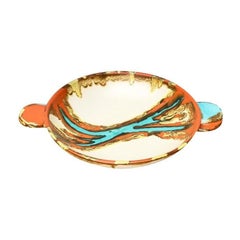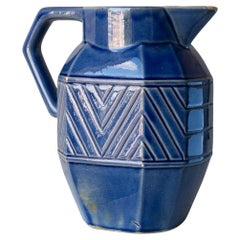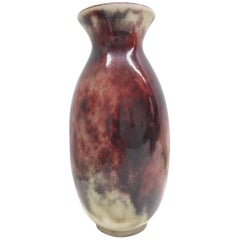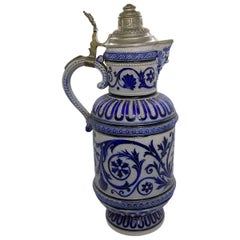1930s German Pottery
to
1
5
1
6
4
2
1
2
Sort By
Art Deco German Pottery Bowl from Carstens Uffrecht Keramik, 1930s
Located in Hamburg, DE
Art Deco German Pottery Bowl from Carstens Uffrecht Keramik, 1930s, in Very Good conditions
Category
20th Century German Art Deco Decorative Bowls
Materials
Ceramic
$2,931
H 2.36 in W 13.39 in D 10.24 in
Art Deco Blue Ceramic Pitcher, France 1930s
By West German Pottery
Located in ROUEN, Normandie
Art Deco Blue Ceramic Pitcher, France 1930s
This ceramic pitcher, typically Art Deco, comes from
Category
Mid-20th Century French Mid-Century Modern Ceramics
Materials
Sandstone, Enamel
Unique Abstract Bauhaus Vase Pottery by WMF Ikora, Germany 1930s Art Deco
By WMF Württembergische Metallwarenfabrik
Located in Kirchlengern, DE
Article: ceramic vase object
Producer: WMF, Germany
Age: 1930s
Description
Category
Mid-20th Century German Art Deco Glass
Materials
Ceramic
German Pottery Vase Ox Blood Glaze WMF Germany Vintage, 1930s
By WMF Württembergische Metallwarenfabrik
Located in Nuernberg, DE
An amazing glazed magnificent pottery vases by noted German manufacturer WMF. With a rich "oxblood
Category
Vintage 1930s German Art Deco Vases
Materials
Pottery
Westerwald Salt Glazed Pottery Beer Ewer Pitcher with Lid, German, 1930s
Located in Nuernberg, DE
A large German Westerwald pottery ewer or pitcher with an animal head spout. Elaborately decorated
Category
Vintage 1930s Austrian Art Nouveau Snuff Boxes and Tobacco Boxes
Materials
Majolica
Early Contemporary HandMade Hand Glazed, 1930s Pitcher Vase Brilliant Blue Green
Located in South Burlington, VT
Vase created in a stunning bluish green handmade and hand glazed finish by Paul Dresler, circa 1930
Category
Early 20th Century German Art Deco Ceramics
Materials
Ceramic, Pottery
$75
H 7.5 in W 5.5 in D 5.5 in
Get Updated with New Arrivals
Save "1930 S German Pottery", and we’ll notify you when there are new listings in this category.
1930s German Pottery For Sale on 1stDibs
At 1stDibs, there are many versions of the ideal piece of 1930s German pottery for your home. Was constructed with extraordinary care, often using ceramic, metal and pottery. You’ve searched high and low for the perfect item from our selection of 1930s German pottery — we have versions that date back to the 20th Century alongside those produced as recently as the 20th Century are available. Each choice in our collection of 1930s German pottery bearing Art Deco, mid-century modern or Scandinavian Modern hallmarks is very popular. Bas Van Pelt, Faïenceries et Emaux de Longwy and Carstens Tönnieshof each produced at least one beautiful object in our assortment of 1930s German pottery that is worth considering.
How Much is a 1930s German Pottery?
A piece of 1930s German pottery can differ in price owing to various characteristics — the average selling price 1stDibs is $1,590, while the lowest priced sells for $75 and the highest can go for as much as $17,400.
Questions About 1930s German Pottery
- How can you tell German pottery?1 Answer1stDibs ExpertOctober 24, 2024To tell German pottery, look on the bottom or inside for a maker's marking. Using trusted online resources, you can then research the marking and identify both the maker and the country in which it operates or operated. Some well-known makers of German pottery include Villeroy & Boch, Meissen, Dresdner Porzellan, Königliche Porzellan Manufaktur, Rosenthal, Fuerstenberg, Nymphenburg, Wallendorfer, Scheurich and ES Keramik. Explore a large collection of German pottery on 1stDibs.
- 1stDibs ExpertNovember 4, 2024To identify German pottery, look over the base or interior for the maker's markings. Many pieces will bear some type of stamp, sticker or other marking, which you can research using trusted online resources to learn who made them. From there, you can read about the maker to determine if the company or artisan is German. Some well-known German makers include Hutschenreuther, Meissen, Arzberg, Fürstenberg, Nymphenburg, Gmundner Keramik, Royal Porcelain Manufacture Berlin, Kahla and Königliche Porzellan-Manufaktur. If you can't find any maker's markings, consider having a certified appraiser or experienced antique dealer help you. Find a wide variety of German pottery on 1stDibs.
- What is German pottery called?1 Answer1stDibs ExpertAugust 20, 2024What German pottery is called depends on its style. Pieces with embossed surfaces and thick, chunky glaze produced in West Germany are nicknamed "Fat Lava." Hard-paste porcelain produced in Germany is sometimes referred to as Meissen or Dresden porcelain, depending on its manufacturer. Early 20th-century pieces that show off naturalistic motifs inspired by the Art Nouveau movement may be called Jugendstil pottery. Shop a large collection of German pottery on 1stDibs.
- 1stDibs ExpertSeptember 23, 2024To identify West German pottery, look on the bottom or interior for markings. Many pieces will have markings with the words "West Germany.” Others may instead or also have markings with the maker's name. By researching the maker's mark, you can determine whether the manufacturer was a West German company. Well-known West German pottery manufacturers include Scheurich, ES Keramik, Ceramano and Ruscha. Some pottery also has an item or piece number on it; this can be used to learn more about your piece's age, style or line name and other characteristics. If you can't find any markings on your piece, you may wish to have a certified appraiser or knowledgeable antique dealer help you with identifying it. On 1stDibs, shop a large collection of West German pottery.
- 1stDibs ExpertApril 16, 2024The markings on West German pottery vary. Nearly all pieces will include the words "West Germany," indicating the place of origin. Some also feature a piece or style number and/or a company logo or marking. You can compare the markings on your pottery to images posted on trusted online resources to identify pieces. On 1stDibs, explore a selection of West German pottery.
- 1stDibs ExpertFebruary 21, 2024A number of brands are West German pottery. Among them are Scheurich, Bay, Carstens, Otto, Ceramano and Dumler and Breiden. Basically, any pottery company that operated in western Germany between 1949 and 1990 can be categorized as West German. On 1stDibs, explore an assortment of pottery from some of the world's top sellers.
- 1stDibs ExpertOctober 30, 2024Yes, some West German pottery is worth something. Fat Lava-style pieces are particularly popular among some collectors, and there is often a demand for pottery produced by specific West German makers, such as Scheurich, ES Keramik, Ceramano and Ruscha. Generally, the age, style, type and condition will influence how much a particular piece may be worth. To get an estimated value for a particular item, consult a certified appraiser or experienced antique dealer. On 1stDibs, shop a selection of West German pottery.
- 1stDibs ExpertApril 5, 2024What the numbers mean on West German pottery varies. In some cases, the numbers represent the date of production. More often, the numbers represent the piece number — indicating what order it was produced in — or the style of the pottery. On 1stDibs, explore a range of West German pottery.





